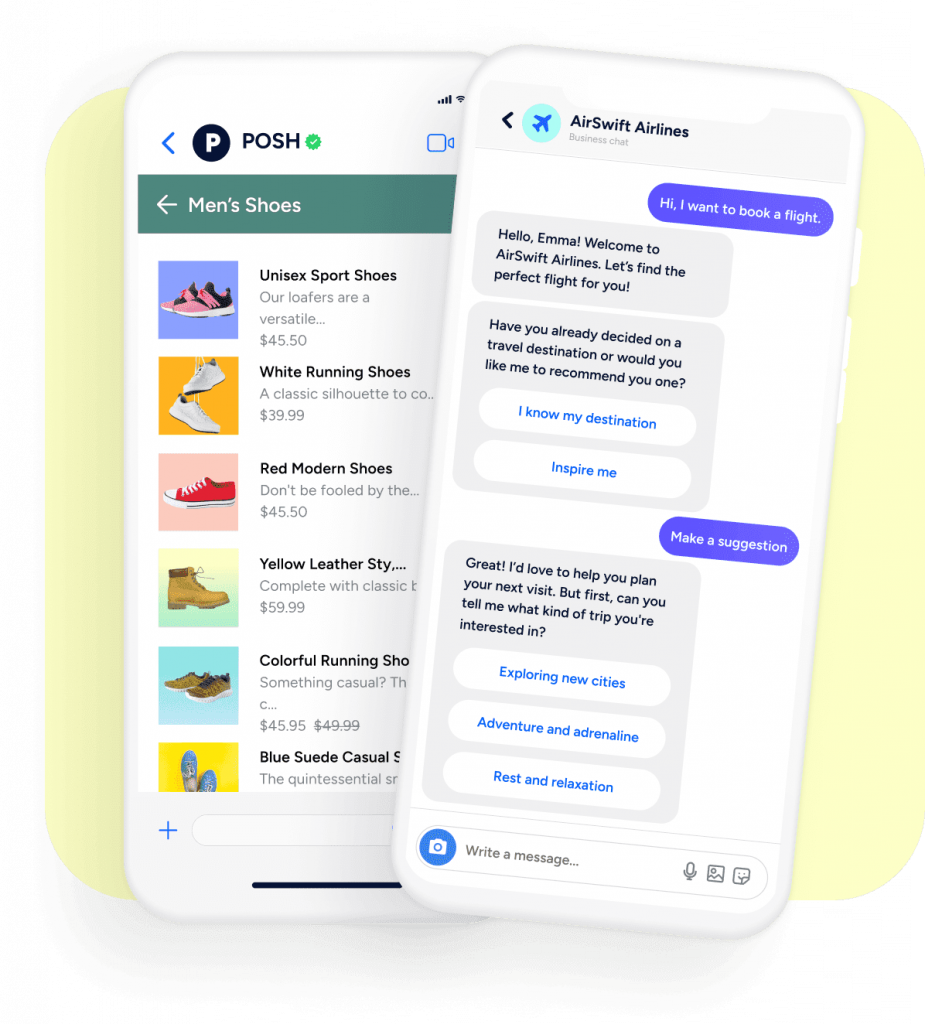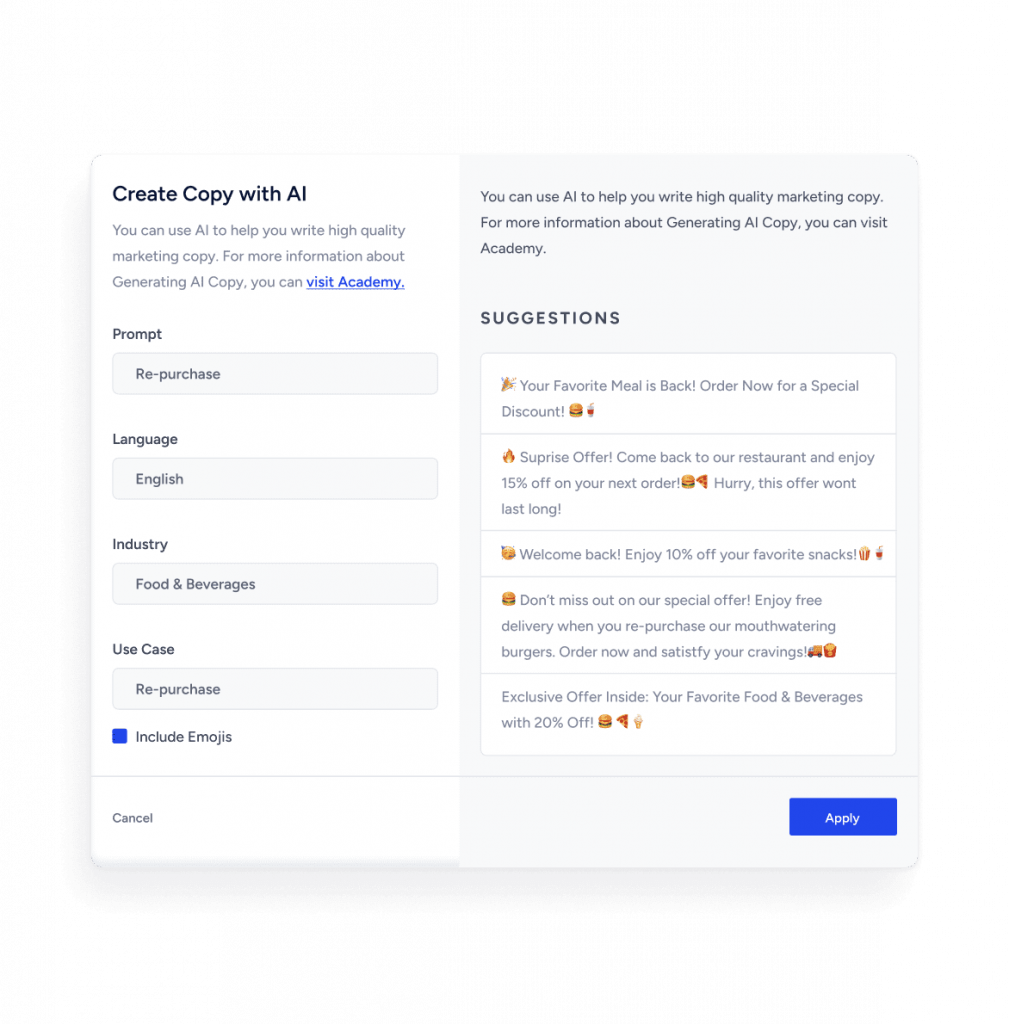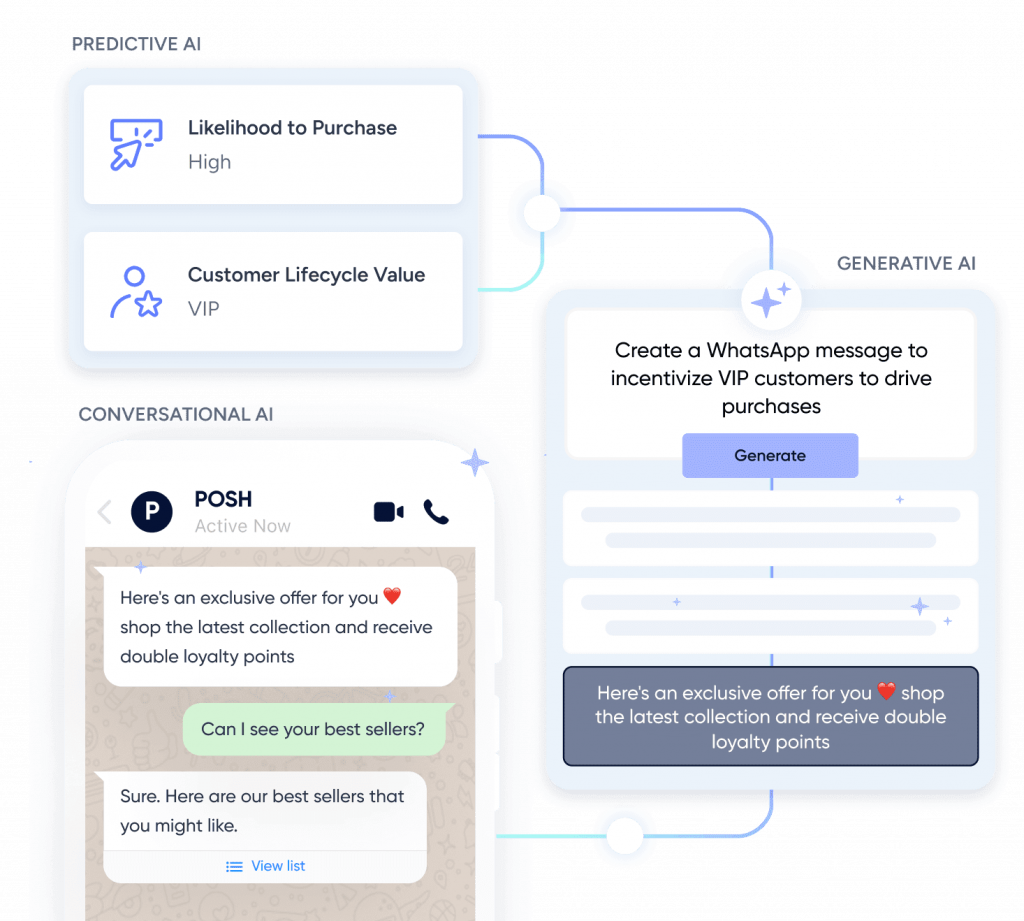Conversational AI vs Generative AI: Differences and use cases
Artificial intelligence (AI) is a very broad term, with Conversational AI and Generative AI being two of its most popular manifestations. While they have some similarities, these two types of AI are designed for different purposes:
Updated on 30 Sep 2025
- Conversational AI is built to have two-way communication with people using human-like interactions. It’s most often built into virtual assistants (e.g., Alexa, Siri, and Google Assistant) or chatbots to ensure fast, high-quality responses to customer support queries at scale.
- Generative AI produces original content — like text, images, videos, music, and code — based on text prompts. It’s a newer form of AI that’s used to generate new ideas, speed up content creation, summarize large amounts of data, and more.
Due to these differences, both types of AI rely on different training data. However, teams today have plenty of opportunities to use both Conversational and Generative AI in their tools and workflows to be more productive and efficient, as well as provide exceptional customer experiences.
In this guide, we’ll explore both AI types in detail, including their differences, use cases, benefits, and use cases. We’ll also look at some of the most popular tools that employ Conversational AI or Generative AI and how they can benefit your business.
What is Conversational AI?
Conversational AI technologies aim to understand human queries and respond to them in a natural way. The user queries and responses can be text-based and voice-based.
Put simply, Conversational AI simulates human conversations. This is possible thanks to various machine learning technologies like natural language processing (NLP).
Conversational AI solutions are trained on large datasets of human conversations. Tools use that information to understand and process human language, allowing it to them human-like conversations with customers, partners, and other parties.
As they gather more data, Conversational AI technologies learn from past conversations to improve response quality and as a result — drive higher customer satisfaction.
Conversational AI use cases and examples
Perhaps the most popular applications of Conversational AI are chatbots and virtual assistants that can understand the intent behind users’ queries and provide quick, human-like responses.
This is extremely useful to larger companies, as it enables them to scale their customer service across touchpoints (like messaging channels) while ensuring fast response times.
For a real-life example, check out our case study with Renault. This large automotive brand was struggling to manage customer interactions in real-time, which often led to long wait times and a poor user experience.
The company realized that relying solely on one-to-one conversations between customers and call center agents took up too much valuable time and led to a drop in productivity in other areas. That’s why our experts suggested incorporating a Conversational AI virtual assistant.

This assistant is now equipped to respond to over 350 different prompts with contextual responses in just 20 seconds across topics like color options and technical specifications. This helped Renault reduce customer service wait times by 93% and achieve a 4% increase in conversion rates.
Benefits of Conversational AI
Conversational AI solutions can bring big benefits to both companies and individuals, including:
- Cost reduction and efficiency: Chatbots and virtual assistants can answer a massive number of queries automatically, which lowers the costs required to run a customer service operation. This also makes customer service agents more effective, as it allows them to focus on high-impact tasks, instead of on repetitive queries.
- Improved customer response times and quality: AI-powered chatbots and virtual assistants can ensure fast customer service 24/7. They can also use customer data (e.g., purchases, preferences, and website interactions) to deliver personalized responses to every user, resulting in higher engagement and satisfaction.
- Convenience and accessibility: Conversational AI saves tons of time and effort from everyday tasks, like transcribing a lecture or Zoom call, giving spoken directions, creating audiobooks, and much more. Plus, people with disabilities or lack of technical skills can use these tools to overcome their challenges while navigating websites, mobile apps, and more.
Conversational AI tools
Many of the largest technology companies offer Conversational AI tools for different businesses and use cases, like:
- Vertex AI Agents, which is a Google service that allows developers to build and deploy AI-powered agents. There’s also a no-code agents console for creating conversational AI agents using natural language.
- Amazon Lex, which is a fully managed AI service for creating conversational interfaces (both voice and text) into applications. Large enterprises like Govchat, Vanguard, and Dropbox rely on this solution for use cases like automating calls, increasing self-service, and boosting workplace productivity.
- IBM Watson Assistant, which is an AI solution conversational that anyone can use to build AI assistants. It’s an user-friendly tool with a drag-and-drop editor and templates, so it’s not exclusively designed for developers and other technical roles.
Besides these standalone tools and services, you can find Conversational AI capabilities incorporated in many marketing platforms.
For example, the Renault use case we showed earlier was made possible by our Conversational CX solution that lets companies have two-way, unstructured conversations with customers across channels like WhatsApp, Facebook Messenger, iMessage, Instagram, and more.

What is Generative AI?
Generative AI refers to the process of creating something new — like text, images, videos, music, code, and even entire products — using the power of generative models. Due to this versatility of tasks, Generative AI solutions are trained on large and diverse data sets and are founded on large language models (LLMs).
Generative AI tools use machine learning and deep learning models to learn the patterns and relationships in content that’s generated by humans. Then, they use that knowledge to generate new content, usually in response to a text prompt.
Generative AI use cases and examples
Generative AI has been all over the news lately, mostly thanks to ChatGPT’s success. As a result, the most popular Generative AI use cases involve an AI chatbot that receives some text prompt and provides a useful output that:
- Gives an answer to a question, e.g., “What’s the tallest mountain in the world?”.
- Summarizes a lot of information, e.g., “Provide a list of the 10 best air purifiers under $500”.
- Generates original content, e.g., “Write an outline for an essay on the topic of the Industrial Revolution”.
- Translates content to multiple languages, uncovers insights from large datasets, and much more.
At the same time, Generative AI can also be embedded in traditional technologies (e.g., search and chatbots) and used in combination with Conversational AI to deliver better customer experiences.
For real-life examples, you can check out Google Cloud’s Generative AI case studies with brands like Wendy’s, GM, and UKG. They’ve all used Generative AI solutions for use cases like improving chatbot experiences, automating answers to customer questions, streamlining code development, and more.
Lastly, Generative AI is still new. That’s why fresh advancements in the field are appearing constantly and the use cases for them will likely expand to various industries like healthcare, eCommerce, financial services, education, and entertainment.
Benefits of Generative AI
Generative AI adoption is still in its infancy compared to other forms of AI. However, more and more organizations are starting to tap into Generative AI solutions due to their potential to:
- Save time and money: Generative AI can drastically speed up and simplify tons of processes — from creating content to gaining insights from data, summarizing large amounts of information, and more. This helps teams speed up their decision-making and work more efficiently, which naturally leads to higher productivity and cost savings.
- Optimize marketing campaign creation: Marketing teams can use Generative AI during the entire process of creating and building campaigns. This includes content generation, segmentation, journey orchestration, automation and many other tasks, resulting in a much faster and more efficient campaign creation process.
- Brainstorm and come up with unexpected ideas: Generative AI tools are useful to people in creative fields due to their ability to generate many ideas using simple text prompts. For example, copywriters can use Generative AI to overcome the dreaded writer’s block that comes from staring at a blank page. The same goes for musicians, animators, and other creative professionals.
Generative AI tools
Despite Generative AI being relatively new, tons of tools on the market are already utilizing it, including:
- ChatGPT, which is the most popular generative AI tool. ChatGPT is a chatbot and virtual assistant, developed by OpenAI and based on LLMs. It helps users write, get quick answers to questions, improve productivity, and much more.
- Gemini (formerly Bard), which is Google’s generative AI chatbot which came as a response to the massive popularity of OpenAI’s ChatGPT. It works in a very similar way to ChatGPT, where users provide text prompts and Gemini generates a response.
- Copilot, which is a Microsoft product that replaced their previous virtual assistant (Cortana). There are several Microsoft Copilot products but at their core, they’re all very similar to ChatGPT. That’s because Copilot utilizes the Microsoft Prometheus model, which is built upon OpenAI’s GPT-4 LLM.
- Claude, which is a family of LLMs developed by Anthropic. Users can leverage Claude for a variety of tasks, including transcribing and analyzing images, generating code, translating between languages, performing complex cognitive tasks, and more.
- Midjourney, which is a generative AI tool that creates images from text prompts. It’s similar to OpenAI’s DALL-E and is often used for brainstorming and quick image generation.
Again, there are now plenty of marketing platforms that incorporate Generative AI into their toolkits. For example, at Insider, we have Sirius AI™ — a patent-pending generative AI solution that helps customers who use our platform achieve up to 60% higher productivity and efficiency.

How Insider can help you leverage the full power of AI
If you’re interested in tapping into the full marketing potential of AI, Insider can be the ideal solution for you. As we showed earlier, our platform combines three types of AI to help teams work more efficiently, raise productivity, and deliver exceptional customer experiences:
- Predictive AI, which analyzes customer data to predict future behaviors, including likelihood to purchase, likelihood to engage on a channel, spending potential, and much more. For example, Monster Notebook used our Predictive AI to improve their ad remarketing, resulting in a 440% increase in conversion rate and a 65% decrease in cost per acquisition.
- Generative AI, which lets you quickly generate campaign copy, images, segments, and even customer journeys with simple text prompts. All you need to do is provide your end goal — like engaging new customers, driving repeat purchases, or preventing churn — and AI will generate relevant results.
Conversational AI, which can engage customers in structured and unstructured conversations across their favorite channels. You can also use brand guidelines and knowledge limits to ensure consistency, confidence, and security for your bots and AI assistants.

Additionally, our platform has used more traditional forms of AI for years. For example, our industry-leading product recommendation engine can analyze large amounts of data and use various algorithms to deliver tailored product recommendations to each customer across all channels.We also have an automated recommendation algorithm (called Chef) that can detect the best combination of algorithms by testing the most popular items, top sellers, user-based, highest discounted, new arrivals, and trending items algorithms for better conversion rates.

To learn more about Insider’s AI functionalities:
- Refer to our guide on the top AI personalization tools. This post explores AI’s marketing use cases and provides a detailed look at 10 of the best tools on the market.
- Check out our case studies with brands like Adidas, Lanvin, and Sapphire. They all used our AI-powered tools to generate more revenue, improve customer engagement, and drive a better return on investment (ROI) from their martech stack.
Book a free demo with our team. Our experts will provide you with a personalized look at how Insider can help you achieve your business goals using the power of AI (and all other tools that we offer).



















